Rye Cookbook Club - The Modern Cook's Year by Anna Jones
Here we are again, the second instalment of Rye Cookbook Club has come and gone so quickly. How did you all get on?
I was excited to get going on this one as I’ve been a fan of Anna Jones for a while. As a veggie she is far from preachy and amongst all of the fads and ill- advice that’s easy to come by in the health food scene, she seems levelheaded and realistic.
Her third book and most recent release, ‘A Modern Cook’s Year’, is an ode to the cyclical nature of the seasons and the produce that comes with them. The book is divided into six sections (Start of the Year, First Warm Days of Spring, Herald of Spring, Summer, Autumn and Winter) as Anna says ‘I find a year divided into four seasons a bit too vague. Just step into a greengrocer on the summer side of autumn and then again as autumn turns into winter and you’ll see the difference. There are so many more subtleties to what’s growing than spring, summer, autumn and winter.’ Musings like this are dotted throughout the book and demonstrate Anna’s attention to detail, genuine care for ingredients and mindful approach that is reflected in her cooking.
One of the reasons I’m drawn to Anna’s work is for her laidback style that doesn’t scare you off or intimidate and this book certainly follows suit. Anna encourages us to use our intuition instead of following the book rigidly, asking us to ‘let your senses… lead you’. She wants it to be used as a guide: the list of seasonal ingredients at the beginning of each chapter to influence rather than dictate, the recipes to inspire rather than be followed to a T.
The ‘flavour maps’ are perfect examples of this. They act as a sort of visual guide on how to make staples in lots of different ways; think soups, salads and traybakes. The fritter flavour map is one that’s come in very handy so far as a speedy weeknight supper. Simply pick an ingredient from each column (a vegetable, a pulse, a spice etc), form into patties and fry. Choose a different ingredient each time and you have a totally different meal in front of you but one that follows the same basic method that you’ll soon learn off by heart. This encourages us to relax, experiment and use our eyes and taste buds to guide us, which is exactly what Anna wants in the reader. It also, in turn, brings around a sense of confidence in the kitchen, and surely that’s the purpose of a cookbook after all?
The first thing I made was the lemon upside down polenta cake but I swapped the lemons for blood oranges. Polenta cake is one of my faves and I like them to be dense, almost pudding-like and eaten with a spoon. This one is different; it’s light and fragrant with a delicate crumb and a hint of cardamom- a nice change from the ones I am used to. It’s also a cinch to make (no sieving of flour, no beating of butter) and very nice with a cup of tea.
The roasted radishes with lentils and new potatoes surprised me. I chose it for it’s inexpensive ingredients list and simple method as I was feeling a little lazy and it turned out to be more than the sum of its parts. I couldn’t find any sorrel in my local Sainsbury’s (no surprises there) but threw in generous handfuls of chopped parsley and dill instead, which were a great addition. I also didn’t have buttermilk to hand so swapped it for kefir (apparently I have kefir to hand nowadays and that makes me sound like a truly stereotypical health-conscious millennial). The radishes (a vegetable I never thought I liked that much) became deliciously charred, the lentils delightfully toothsome (though I did have to cook them for double the time suggested to reach full crispy-ness) and the potatoes bulked it out nicely, making it substantial and satisfying whilst still feeling light. The creamy dressing, aromatic herbs and an extra load of lemon zest to finish it off resulted in a fresh and colourful little traybake that’s perfect for spring. It was lovely as a side with fish and leftovers made a good packed lunch the next day.
The chocolate truffles are another winner. They can be made in a matter of minutes with literally no skill required but will still impress anyone who tries them. Instead of going to the shops specifically I used what was already in the cupboard: a mix of milk and dark chocolate, peanut butter instead of almond, caster sugar instead of coconut. Yes, perhaps not as nutritious as Anna’s but delicious nonetheless. I found rolling the truffles in their coatings as Anna suggests to be rather fruitless as nothing seemed to stick so I’ve since taken to sprinkling these bits on top before leaving the chocolate to set. And yes, that does mean I’ve made them multiple times…
I also made the tomato tarte tatin a while ago for a family gathering that was inhaled within minutes and the egg flatbreads are a good go-to when there’s not much in the fridge.
For me, Anna’s appeal lies in the way she uses simple ingredients in a creative way, layering textures, flavours and colours to create beautiful dishes that praise vegetables in their own right. These are the type of veggie recipes that meat-eaters will enjoy just as much as vegetarians because they’re complex and exciting, whilst somehow remaining modest and unfussy.
Most of the recipes are adaptable, using simple, readily available ingredients and store cupboard essentials, which makes everything a lot less stressful. Alternatives can often be swapped in if something a little more obscure is called for and similar staple ingredients show up throughout the book so that you’re not buying things you won’t reuse.
Health is clearly an important factor for Anna but her background as a chef and her realistic food philosophy means that the main focus of the recipes is always how they taste, above anything else. There is plenty of hearty, comfort food in there too; things like squash polpette with pesto spaghetti, kale and mushroom lasagne, toasted coconut rice pudding, lentil gratin and gnocchi with brown butter tomato sauce (this one’s a goody). The fact that it’s all incredibly nutritious is just a happy bonus.
That’s the thing with Anna, she’s realistic. She wants to eat well and do well for the environment but she also acknowledges that we have to treat ourselves with care and part of that is eating exactly as we want in that moment- being led by our hearts and palates. Unlike a huge amount of vegetarian or healthy cookbooks, A Modern Cook’s Year is practical and unpretentious and doesn’t lose sight of it’s goal- to celebrate seasonal vegetables and inspire us readers on how to make the most of them while they’re around. It also acts as a reminder to listen to what our bodies want at any point throughout the year and to act accordingly…
‘Some days dinner comes entirely from the store cupboard… sometimes its macaroni cheese in July, and if that’s what I crave, so be it.’ Hear, hear.
If you're cooking along wit us, make sure to tag us in your creations and use the #ryecookbookclub







